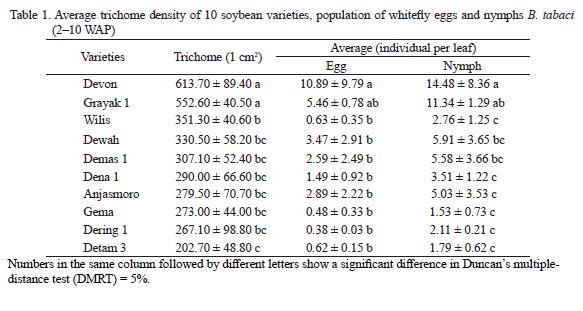Bemisia tabaci (Hemiptera: Aleyrodidae): evaluation of leaf trichome density based resistance on several soybean varieties
Main Article Content
Abstract
The whitefly Bemisia tabaci (Gennadius) is one of the important soybean pests which can reduce production up to 80 %. Soybean defense mechanism against B. tabaci is affected by the physical characteristics of the leaf surface, e.g. leaf thickness, density of trichomes, and sticky glandular trichomes. The objective of this research was to investigate B. tabaci population – trichome density relationship on ten soybean varieties. The experiment was carried out in Ngale Station, Ngawi District, East Java. The tested soybean varieties were Anjasmoro, Demas 1, Dena 1, Dering 1, Devon, Detam 3, Dewah, Gema, Grayak 1, and Wilis. The experiment was done by completely randomized design with three replications. Observation on the whitefly population was conducted weekly from 2 until 10 weeks after planting on 23 sample plants in each plot. The result showed that Devon was the variety with the highest population levels of B. tabaci, 10.89 (eggs), 14.48 (nymphs) individuals per leaf, respectively. The population of B. tabaci was affected by trichomes density. Devon was the highest density of trichomes (613.7 hairs per cm2). The density of trichomes and the number of whitefly eggs and nymphs relationship were significant (R2= 0,78 (egg) and 0.84 (nymph), n= 10, ?= 1 %, F Value= 0.00157, respectively).
Article Details

This work is licensed under a Creative Commons Attribution-NonCommercial 4.0 International License.
References
Arif MJ, Gogi MD, Mirza M, Zia K, & Hafeez F. 2006. Impact of plant spacing and abiotics factors on population dynamics of sucking insect pest of cotton. Pak. J. Biol. Sci. 9(7): 1364–1369. https://doi.org/10.3923/pjbs.2006.1364.1369
Bonato O, Lurette A, Vidal C, & Fargues J. 2007. Modelling temperature-dependent bionomics of Bemisia tabaci (Q-biotype). Physiol. Entomol. 32(1): 50–55. https://doi.org/10.1111/j.1365-3032.2006.00540.x
Butler GD, Henneberry TJ, & Clayton TE. 1983. Bemisia tabaci (Homoptera: Aleyrodidae): development, oviposition, and longetivity in relation to temperature. Ann. Entomol. Soc. Am. 76(2): 310–313. https://doi.org/10.1093/aesa/76.2.310
Chu CC, Henneberry TJ, & Cohen AC. 1995. Bemisia argentifolii (Homoptera: Aleyrodidae): host preference and factors affecting oviposition and feeding site preference. Environ. Entomol. 24(2): 354–360. https://doi.org/10.1093/ee/24.2.354
Dalin P, Agren J, Bjorkman C, Huttunen P, & Karkkainen K. 2008. Leaf trichome formation and plant resistance to herbivory. In: Schaller A (Ed.). Induced Plant Resistance to Herbivory. pp. 89–105. Springer, Dordrecht. https://doi.org/10.1007/978-1-4020-8182-8
Faiz MF, Hidayat P, Winasa IW, & Guntoro D. 2021. Effect of soybean leaf trichomes on the preference of various soybean pests on field. IOP Conf. Ser.: Earth Environ. Sci. 694: 012046.
Fürstenberg-Hägg J, Zagrobelny M, & Bak S. 2013. Plant defense against insect herbivores. Int. J. Mol. Sci. 14(5): 10242-10297.
Hasanuzzaman ATM, Islam MN, Zhang Y, Zhang CY, & Liu TX. 2016. Leaf morphological characters can be a factor for intra-varietal preference of whitefly Bemisia tabaci (Hemiptera: Aleyrodidae) among eggplant varieties. PLoS ONE. 11(4): e0153880.
Heinz KM & Zalom FG. 1995. Variation on trichome-based resistance to Bemisia argentifolii (Homoptera: Aleyrodidae) oviposition on tomato. J. Econ. Entomol. 88(5): 1494–1502. https://doi.org/10.1093/jee/88.5.1494
Hua LZ, Lammes F, van Lenteren JC, Huisman PWT, van Vianen A, & de Ponti OMB. 1987. The parasite-host relationship between Encarsia formosa Gahan (Hymenoptera, Aphelinidae) Trialeurodes vaporariorum (Westwood) (Homoptera, Aleyrodidae): XXV. Influence of leaf structure on the searching activity of Encarsia formosa. J. Appl. Entomol. 104(1–5): 297–304.
Hendrival, Latifah, & Hayu R. 2013. Perkembangan Spodoptera litura F. (Lepidoptera: Noctuidae) pada kedelai [Portrayals of Spodoptera litura F. (Lepidoptera: Noctuidae) in soybean]. J. Floratek. 8(2): 88–100.
Jones DR. 2003. Plant viruses transmitted by whiteflies. Eur. J. Plant. Pathol. 109: 195–219. https://doi.org/10.1023/A:1022846630513
Lutfi M, Hidayat P, & Maryana N. 2019. Correlation between epidermis thickness, leaf trichome length and density with the whitefly Bemisia tabaci population on five local soybean cultivars. Jurnal Perlindungan Tanaman Indonesia. 23(1): 23– 31. https://doi.org/10.22146/jpti.34498
Mansaray A & Sundufu AJ. 2009. Oviposition, development and survivorship of the sweetpotato whitefly Bemisa tabaci on soybean Glycine max, and the garden bean, Phaseolus vulgaris. J. Insect. Sci. 9: 1. https://doi.org/10.1673/031.009.0101
Marwoto & Inayati A. 2011. Kutu kebul: hama kedelai yang pengendaliannya kurang mendapat perhatian [Whitefly: soybean pest whose control is not getting enough attention]. Iptek Tanaman Pangan. 6(1). 87–98.
Ministry of Agriculture. 2015. Outlook for agricultural commodities food crops subsector soybean. Pusat Data dan Informasi Pertanian Pr. Jakarta.
Russel GE. 1978. Plant Breeding for Pest and Disease Resistance. Butterworth-Heinemann. London. https://doi.org/10.1016/C2013-0-06283-4
Sharma AN, Gupta GK, Verma RK, Sharma OP, Bhagat S, Amaresan N, Saini MR, Chattopadhyay C, Sushil SN, Asre R, Kapoor KS, Satyagopal K, & Jeyakumar P. 2014. Integrated Pest Management Package for Soybean. National Centre for Integrated Pest Management. New Delhi.
Sulistyo A. 2016. Kriteria seleksi penentuan ketahanan kedelai terhadap kutu kebul [Selection criteria for determining soybean resistance to whitefly]. Iptek Tanaman Pangan. 11(1): 78–80.
Yousaf U, Asgher A, & Iqbal J. 2018. Morphological, physiological, and molecular markers for the development of resistance in cotton against insect pests. Asian J. Crop Sci. 2(4): 1–12. https://doi.org/10.9734/AJRCS/2018/46537

